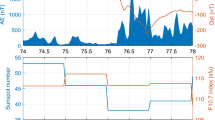Abstract
Ionosphere total electron content (TEC) from global ionospheric maps (GIM) is widely applied in both ionospheric delay correction and research on space weather monitoring. Global ionospheric modeling based on multisource data is an effective method to improve conventional GIM accuracy and reliability. In this study, a global ionospheric model is constructed from multi-GNSS (here, GPS/GLONASS/BDS), satellite altimetry and Formosat-3/COSMIC (F3/C) observations using a spherical harmonic (SH) function. The results show that compared to the conventional GIM derived from GPS/GLONASS data, the combined GIM performance from multisource data improves significantly; the RMS versus external data decreases from [2, 5] to [2, 3] TECU, and the BIAS decreases from [− 3, 1] to [− 1, 1] TECU. Specifically, BDS observations improve the IPP distributions, especially over the region of Australia; compared with GPS-based ionospheric TEC. Our calculated GIM with BDS data has better performance than that without BDS data. By combining JASON 2 and GPS/GLONASS data, the residual distribution is more concentrated, and the RMS is improved effectively in mid-high latitudes of the southern hemisphere and in the equatorial region. F3/C TEC also exhibits relatively minor improvements on GIM; the standard deviation reduces from 2.89 to 1.92 TECU, and the BIAS regarding extra F3/C data decreases from − 2.02 to − 1.71 TECU.














Similar content being viewed by others
References
Alizadeh MM, Schuh H, Todorova S, Schmidt M (2011) Global ionosphere maps of VTEC from GNSS, satellite altimetry, and Formosat-3/COSMIC data. J Geodesy 85(12):975–987
Brunini C, Meza A, Bosch W (2005) Temporal and spatial variability of the bias between TOPEX- and GPS-derived total electron content. J Geodesy 79(4–5):175–188
Chen P, Yao W, Zhu X (2015) Combination of ground-and space-based data to establish a global ionospheric grid model. IEEE Trans Geosci Remote Sens 53(2):1073–1081
Chen P, Yao Y, Yao W (2017) Global ionosphere maps based on GNSS, satellite altimetry, radio occultation and DORIS. GPS Solut 21(2):639–650
Dettmering D, Schmidt M, Heinkelmann R, Seitz M (2011) Combination of different space-geodetic observations for regional ionosphere modeling. J Geod 85(12):989–998
Feltens J (2007) Development of a new three-dimensional mathematical ionosphere model at European space agency/European space operations centre. Space Weather 5(12):1–17
Hernández-Pajares M, Juan JM, Sanz J (1999) New approaches in global ionospheric determination using ground GPS data. J Atmos Solar-Terr Phys 61(16):1237–1247
Hernández-Pajares M, Juan JM, Sanz J, Orus R, Garcia-Rigo A, Feltens J, Komjathy A, Schaer SC, Krankowski A (2009) The IGS VTEC maps: a reliable source of ionospheric information since 1998. J Geodesy 83(3):263–275
Imel DA (1994) Evaluation of the TOPEX/POSEIDON dual-frequency ionosphere correction. J Geophys Res: Oceans 99(C12):24895–24906
Koch KR, Kusche J (2002) Regularization of geopotential determination from satellite data by variance components. J Geodesy 76(5):259–268
Li Z, Yuan Y, Li H, Ou J, Huo X (2012) Two-step method for the determination of the differential code biases of COMPASS satellites. J Geodesy 86(11):1059–1076
Li Z, Yuan Y, Wang N, Hernandez-Pajares M, Huo X (2015) SHPTS: towards a new method for generating precise global ionospheric TEC map based on spherical harmonic and generalized trigonometric series functions. J Geodesy 89(4):331–345
Liou YA, Pavelyev AG, Matugov SS, Yakovlev OI, Wickert J (2010) Radio occultation method for remote sensing of the atmosphere and ionosphere. I-Tech Education and Publishing KG, Croatia, p 176 (ISBN 978-953-7619-60-2)
Mannucci AJ, Wilson BD, Yuan DN, Ho CH, Lindqwister UJ, Runge TF (1998) A global mapping technique for GPS-derived ionospheric total electron content measurements. Radio Sci 33(3):565–582
Orús R, Hernández-Pajares M, Juan JM, Sanz J, Garcia-Fernandez M (2003) Validation of the GPS TEC maps with TOPEX data. Adv Space Res 31(3):621–627
Roma-Dollase D et al (2017) Consistency of seven different GNSS global ionospheric mapping techniques during one solar cycle. J Geodesy 92(6):691–706
Schaer S (1999) Mapping and predicting the earths ionosphere using the global positioning system. Ph.D. thesis, Ph.D. dissertation. University of Bern, Bern
Sun YY, Liu JY, Tsai HF, Krankowski A (2017) Global ionosphere map constructed by using total electron content from ground-based GNSS receiver and FORMOSAT-3/COSMIC GPS occultation experiment. GPS Solut 21(4):1583–1591
Tang W, Jin L, Xu K (2014) Performance analysis of ionosphere monitoring with BeiDou CORS observational data. J Navig 67(3):511–522
Xue J, Song S, Zhu W (2016) Estimation of differential code biases for Beidou navigation system using multi-GNSS observations: how stable are the differential satellite and receiver code biases? J Geodesy 90(4):309–321
Yuan Y, Tscherning CC, Knudsen P, Xu G, Ou J (2008) The ionospheric eclipse factor method (IEFM) and its application to determining the ionospheric delay for GPS. J Geodesy 82(1):1–8
Zhang H, Xu P, Han W, Ge M, Shi C (2013) Eliminating negative VTEC in global ionosphere maps using inequality-constrained least squares. Adv Space Res 51(6):988–1000
Zhang R, Song WW, Yao YB, Shi C, Lou YD, Yi WT (2015) Modeling regional ionospheric delay with ground-based BeiDou and GPS observations in China. GPS Solut 19(4):649–658
Acknowledgements
This work was supported by the National Key Research and Development Program of China (No. 2016YFB0501803), the National Natural Science Foundation of China (No. 41574028), and the Natural Science Foundation for Distinguished Young Scholars of Hubei Province of China (No. 2015CFA036). The authors gratefully acknowledge the CDDIS for GNSS observations, NOAA for satellite altimetry data, and CDAAC for F3/C “ionPrf” products.
Author information
Authors and Affiliations
Corresponding authors
Rights and permissions
About this article
Cite this article
Yao, Y., Liu, L., Kong, J. et al. Global ionospheric modeling based on multi-GNSS, satellite altimetry, and Formosat-3/COSMIC data. GPS Solut 22, 104 (2018). https://doi.org/10.1007/s10291-018-0770-6
Received:
Accepted:
Published:
DOI: https://doi.org/10.1007/s10291-018-0770-6




